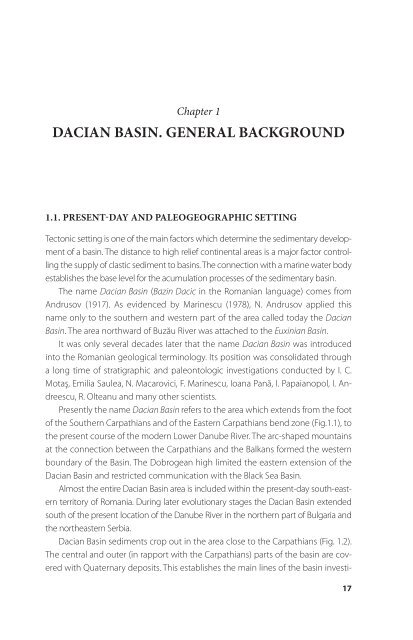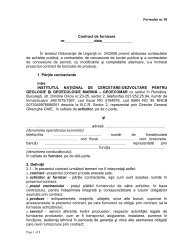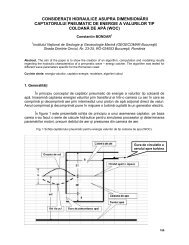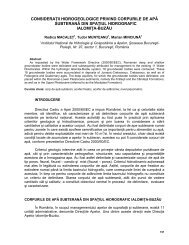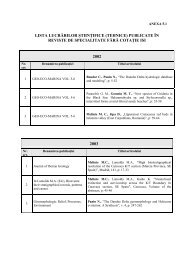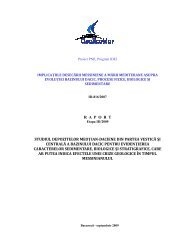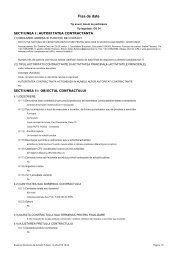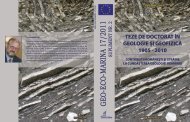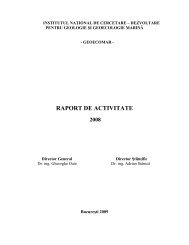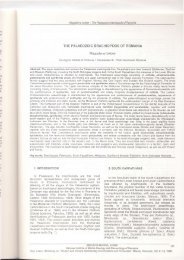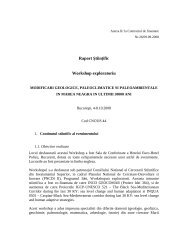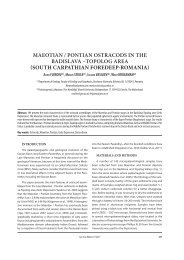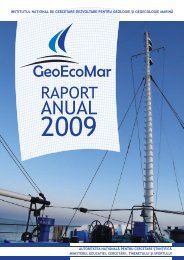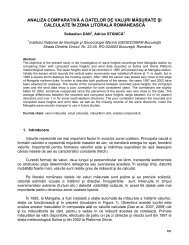- Page 1: Dan C. Jipa, Cornel Olariu DACIAN B
- Page 5: Dedicated to the memory of Prof. Gh
- Page 8 and 9: NATIONAL INSTITUTE OF MARINE GEOLOG
- Page 11 and 12: CONTENTS Foreword and Acknowledgeme
- Page 13 and 14: Contents Chapter 7. The Point Bar F
- Page 15 and 16: FOREwORD AND ACkNOwLEDgEMENTS The s
- Page 17: PLATE 1. Location of the Dacian Bas
- Page 21 and 22: 1.2. Stratigraphy gation method: di
- Page 23 and 24: 1.2. Stratigraphy FIGURE 1.3. Parat
- Page 25 and 26: 1.2. Stratigraphy poral limits of t
- Page 27 and 28: 1.2. Stratigraphy a) the sampling r
- Page 29 and 30: 1.3. Outline of the Dacian Basin bi
- Page 31 and 32: 1.3. Outline of the Dacian Basin bi
- Page 33 and 34: 1.4. Dacian Basin structural framew
- Page 35 and 36: 1.5. Overview of the Dacian Basin c
- Page 37 and 38: 1.5. Overview of the Dacian Basin c
- Page 39 and 40: 1.6. Nomenclature FIGURE 1.10. Main
- Page 41 and 42: 1.6. Nomenclature Also, Quirk et al
- Page 43 and 44: 2.1. Dacian Basin paleogeographic e
- Page 45 and 46: 2.1. Dacian Basin paleogeographic e
- Page 47 and 48: 2.1. Dacian Basin paleogeographic e
- Page 49 and 50: 2.1. Dacian Basin paleogeographic e
- Page 51 and 52: 2.1. Dacian Basin paleogeographic e
- Page 53 and 54: 2.2. Dacian Basin paleogeographic c
- Page 55 and 56: 2.2. Dacian Basin paleogeographic c
- Page 57 and 58: 2.2. Dacian Basin paleogeographic c
- Page 59 and 60: 2.2. Dacian Basin paleogeographic c
- Page 61 and 62: 2.3. Was the Dacian Basin a lake or
- Page 63 and 64: 2.3. Was the Dacian Basin a lake or
- Page 65 and 66: 2.3. Was the Dacian Basin a lake or
- Page 67 and 68: 2.4. Conclusions The Dacian Basin s
- Page 69 and 70:
Quaternary deposits cover the centr
- Page 71 and 72:
3.2. Dacian Basin sediment thicknes
- Page 73 and 74:
3.2. Dacian Basin sediment thicknes
- Page 75 and 76:
3.2. Dacian Basin sediment thicknes
- Page 77 and 78:
3.3. Sediment thickness in the East
- Page 79 and 80:
3.3. Sediment thickness in the East
- Page 81 and 82:
3.3. Sediment thickness in the East
- Page 83 and 84:
■ ■ ■ ■ ■ 3.5. Conclusion
- Page 85 and 86:
4.1. Tectonic effects on the Dacian
- Page 87 and 88:
4.2. Dacian Basin shelf and trough
- Page 89 and 90:
4.2. Dacian Basin shelf and trough
- Page 91 and 92:
4.3. Dacian Basin sedimentation dep
- Page 93 and 94:
4.3. Dacian Basin sedimentation dep
- Page 95 and 96:
Chapter 5 LITTORAL SEDIMENTARY ENvI
- Page 97 and 98:
5.2. Shoreline sedimentation enviro
- Page 99 and 100:
5.2. Shoreline sedimentation enviro
- Page 101 and 102:
5.2. Shoreline sedimentation enviro
- Page 103 and 104:
5.2. Shoreline sedimentation enviro
- Page 105 and 106:
5.2. Shoreline sedimentation enviro
- Page 107 and 108:
5.2. Shoreline sedimentation enviro
- Page 109 and 110:
5.2. Shoreline sedimentation enviro
- Page 111 and 112:
5.2. Shoreline sedimentation enviro
- Page 113 and 114:
5.2. Shoreline sedimentation enviro
- Page 115 and 116:
5.2. Shoreline sedimentation enviro
- Page 117 and 118:
5.3 Deltaic environment in the Daci
- Page 119 and 120:
5.3 Deltaic environment in the Daci
- Page 121 and 122:
5.3 Deltaic environment in the Daci
- Page 123 and 124:
5.3 Deltaic environment in the Daci
- Page 125 and 126:
5.3 Deltaic environment in the Daci
- Page 127 and 128:
5.3 Deltaic environment in the Daci
- Page 129 and 130:
5.4. Soft sediment deformation in t
- Page 131 and 132:
5.5. Dacian Basin sedimentary envir
- Page 133 and 134:
5.5. Dacian Basin sedimentary envir
- Page 135 and 136:
5.6. Conclusions The storm-generate
- Page 137 and 138:
6.1. Sedimentary characteristics of
- Page 139 and 140:
6.1. Sedimentary characteristics of
- Page 141 and 142:
6.1. Sedimentary characteristics of
- Page 143 and 144:
6.1. Sedimentary characteristics of
- Page 145 and 146:
6.1. Sedimentary characteristics of
- Page 147 and 148:
6.1. Sedimentary characteristics of
- Page 149 and 150:
6.2. Dacian Basin fluvial sedimenta
- Page 151 and 152:
6.2. Dacian Basin fluvial sedimenta
- Page 153 and 154:
6.2. Dacian Basin fluvial sedimenta
- Page 155 and 156:
6.2. Dacian Basin fluvial sedimenta
- Page 157 and 158:
6.2. Dacian Basin fluvial sedimenta
- Page 159 and 160:
7.1. The geology of the Jilţ Quarr
- Page 161 and 162:
7.1. The geology of the Jilţ Quarr
- Page 163 and 164:
7.2. The sedimentological descripti
- Page 165 and 166:
7.2. The sedimentological descripti
- Page 167 and 168:
7.2. The sedimentological descripti
- Page 169 and 170:
7.2. The sedimentological descripti
- Page 171 and 172:
7.2. The sedimentological descripti
- Page 173 and 174:
7.2. The sedimentological descripti
- Page 175 and 176:
7.2. The sedimentological descripti
- Page 177 and 178:
7.2. The sedimentological descripti
- Page 179 and 180:
7.2. The sedimentological descripti
- Page 181 and 182:
7.3. Mud drapes characters and dist
- Page 183 and 184:
7.3. Mud drapes characters and dist
- Page 185 and 186:
7.3. Mud drapes characters and dist
- Page 187 and 188:
7.4. Genetic significance of the sa
- Page 189 and 190:
7.4. Genetic significance of the sa
- Page 191 and 192:
Clay is one of the most frequent ro
- Page 193 and 194:
8.2. Clay facies and sedimentary se
- Page 195 and 196:
8.3. Sediment accumulation paleoenv
- Page 197 and 198:
8.4. The paleobiologic environment
- Page 199 and 200:
8.6. Conclusions stratification. In
- Page 201 and 202:
9.2. Major features of the Dacian B
- Page 203 and 204:
9.3. Carpathian source-areas The ea
- Page 205 and 206:
9.4. Southern, Balkanian and Dobrog
- Page 207 and 208:
9.5. Paleocurrent directions and se
- Page 209 and 210:
9.5. Paleocurrent directions and se
- Page 211 and 212:
9.6. Sediment source-areas during t
- Page 213 and 214:
9.7. Conclusions land are dominantl
- Page 215 and 216:
10.1. Sediment accumulation areas i
- Page 217 and 218:
10.2. Dacian Basin paleocurrent pat
- Page 219 and 220:
10.2. Dacian Basin paleocurrent pat
- Page 221 and 222:
10.2. Dacian Basin paleocurrent pat
- Page 223 and 224:
10.2. Dacian Basin paleocurrent pat
- Page 225 and 226:
10.2. Dacian Basin paleocurrent pat
- Page 227 and 228:
10.4. Control factors of the sedime
- Page 229 and 230:
10.5 Conclusions After the developm
- Page 231 and 232:
Chapter 11 FROM BRACkISH-MARINE TO
- Page 233 and 234:
11.1. Late Pontian-Romanian regress
- Page 235 and 236:
11.1. Late Pontian-Romanian regress
- Page 237 and 238:
11.1. Late Pontian-Romanian regress
- Page 239 and 240:
11.1. Late Pontian-Romanian regress
- Page 241 and 242:
11.2. The Dacian Basin transition f
- Page 243 and 244:
11.2. The Dacian Basin transition f
- Page 245 and 246:
11.2. The Dacian Basin transition f
- Page 247 and 248:
Chapter 12 DACIAN BASIN IN THE PARA
- Page 249 and 250:
12.2. Sedimentary relationships bet
- Page 251 and 252:
12.2. Sedimentary relationships bet
- Page 253 and 254:
12.3. Comparative sedimentary evolu
- Page 255 and 256:
12.3. Comparative sedimentary evolu
- Page 257 and 258:
12.3. Comparative sedimentary evolu
- Page 259 and 260:
References BA l d i,. t., 1979. Cha
- Page 261 and 262:
References Ji P A d. C., ol A r i u
- Page 263 and 264:
References PA n ă, i., en A C h e,
- Page 265 and 266:
References simionesCu, i., 1903. Co
- Page 268:
ISBN 978-973-0-07021-7


